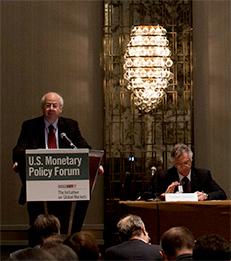Research Highlights
Market Tantrums and Monetary Policy
—


Using inflows and outflows for different types of open-end mutual funds, we find some support for the proposition that market tantrums can arise without any leverage or actions taken by leveraged intermediaries.
Leverage isn’t the only driver of financial instability, according to new research that focuses on how market “tantrums” can arise even in the absence of leverage, and possibly in response to central bank policy.
One such tantrum – involving a selloff and a sharp rise of risk premia in many bond markets – occurred in the spring and summer of 2013, when the Federal Reserve indicated that it might begin to taper its purchase of bonds.
In their paper “Market Tantrums and Monetary Policy,” NYU Stern Professor Kim Schoenholtz and co-authors Michael Feroli, Anil K. Kashyap, and Hyun Song Shin build an analytical framework that can guide policymakers in preventing financial instability.
The authors show how unleveraged intermediaries – concerned about their relative performance – have incentives to herd into and out of risky assets at the same time, prompting bouts of low and high market volatility. Their example also shows how central bank policy, such as forward guidance that aims at keeping interest rates low to stimulate the economy, can promote herding and lead to volatility jumps. In practice, changes in the stance of monetary policy can trigger heavy fund inflows and outflows. According to Schoenholtz: “Using inflows and outflows for different types of open-end mutual funds, we find some support for the proposition that market tantrums can arise without any leverage or actions taken by leveraged intermediaries. We also uncover connections between the destabilizing flows and shocks to monetary policy.”
The authors warn that different policy tools are necessary to address instability driven by non-leveraged investors, challenging the common view that central banks can ignore financial stability in setting interest rates. “The usual prudential tools for limiting leverage – like capital regulation – don’t address these challenges,” says Schoenholtz. “As a result, central banks may sometimes wish to use interest rate policy to secure financial stability.”
___
Kim Schoenholtz is a Professor of Management Practice in the Department of Economics and the Director of the Center for Global Economy and Business.
Photo credit: Beth Rooney
One such tantrum – involving a selloff and a sharp rise of risk premia in many bond markets – occurred in the spring and summer of 2013, when the Federal Reserve indicated that it might begin to taper its purchase of bonds.
In their paper “Market Tantrums and Monetary Policy,” NYU Stern Professor Kim Schoenholtz and co-authors Michael Feroli, Anil K. Kashyap, and Hyun Song Shin build an analytical framework that can guide policymakers in preventing financial instability.
The authors show how unleveraged intermediaries – concerned about their relative performance – have incentives to herd into and out of risky assets at the same time, prompting bouts of low and high market volatility. Their example also shows how central bank policy, such as forward guidance that aims at keeping interest rates low to stimulate the economy, can promote herding and lead to volatility jumps. In practice, changes in the stance of monetary policy can trigger heavy fund inflows and outflows. According to Schoenholtz: “Using inflows and outflows for different types of open-end mutual funds, we find some support for the proposition that market tantrums can arise without any leverage or actions taken by leveraged intermediaries. We also uncover connections between the destabilizing flows and shocks to monetary policy.”
The authors warn that different policy tools are necessary to address instability driven by non-leveraged investors, challenging the common view that central banks can ignore financial stability in setting interest rates. “The usual prudential tools for limiting leverage – like capital regulation – don’t address these challenges,” says Schoenholtz. “As a result, central banks may sometimes wish to use interest rate policy to secure financial stability.”
___
Kim Schoenholtz is a Professor of Management Practice in the Department of Economics and the Director of the Center for Global Economy and Business.
Photo credit: Beth Rooney
